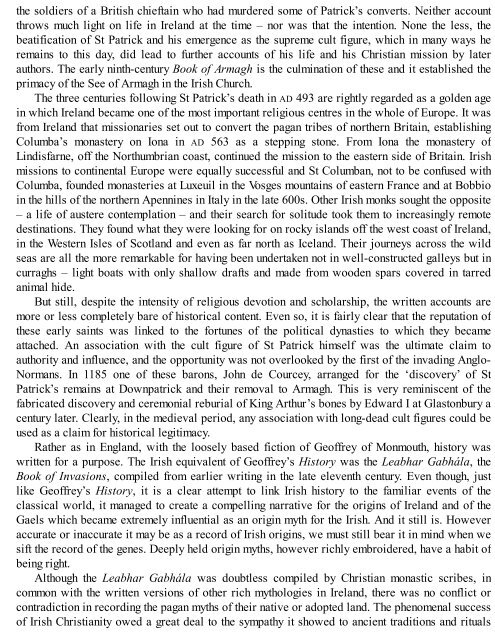Create successful ePaper yourself
Turn your PDF publications into a flip-book with our unique Google optimized e-Paper software.
the soldiers of a British chieftain who had murdered some of Patrick’s converts. Neither account<br />
throws much light on life in Ireland at the time – nor was that the intention. None the less, the<br />
beatification of St Patrick and his emergence as the supreme cult figure, which in many ways he<br />
remains to this day, did lead to further accounts of his life and his Christian mission by later<br />
authors. The early ninth-century Book of Armagh is the culmination of these and it established the<br />
primacy of the See of Armagh in the Irish Church.<br />
The three centuries following St Patrick’s death in AD 493 are rightly regarded as a golden age<br />
in which Ireland became one of the most important religious centres in the whole of Europe. It was<br />
from Ireland that missionaries set out to convert the pagan tribes of northern Britain, establishing<br />
Columba’s monastery on Iona in AD 563 as a stepping stone. From Iona the monastery of<br />
Lindisfarne, off the Northumbrian coast, continued the mission to the eastern side of Britain. Irish<br />
missions to continental Europe were equally successful and St Columban, not to be confused with<br />
Columba, founded monasteries at Luxeuil in the Vosges mountains of eastern France and at Bobbio<br />
in the hills of the northern Apennines in Italy in the late 600s. Other Irish monks sought the opposite<br />
– a life of austere contemplation – and their search for solitude took them to increasingly remote<br />
destinations. They found what they were looking for on rocky islands off the west coast of Ireland,<br />
in the Western Isles of Scotland and even as far north as Iceland. Their journeys across the wild<br />
seas are all the more remarkable for having been undertaken not in well-constructed galleys but in<br />
curraghs – light boats with only shallow drafts and made from wooden spars covered in tarred<br />
animal hide.<br />
But still, despite the intensity of religious devotion and scholarship, the written accounts are<br />
more or less completely bare of historical content. Even so, it is fairly clear that the reputation of<br />
these early saints was linked to the fortunes of the political dynasties to which they became<br />
attached. An association with the cult figure of St Patrick himself was the ultimate claim to<br />
authority and influence, and the opportunity was not overlooked by the first of the invading Anglo-<br />
Normans. In 1185 one of these barons, John de Courcey, arranged for the ‘discovery’ of St<br />
Patrick’s remains at Downpatrick and their removal to Armagh. This is very reminiscent of the<br />
fabricated discovery and ceremonial reburial of King Arthur’s bones by Edward I at Glastonbury a<br />
century later. Clearly, in the medieval period, any association with long-dead cult figures could be<br />
used as a claim for historical legitimacy.<br />
Rather as in England, with the loosely based fiction of Geoffrey of Monmouth, history was<br />
written for a purpose. The Irish equivalent of Geoffrey’s History was the Leabhar Gabhála, the<br />
Book of Invasions, compiled from earlier writing in the late eleventh century. Even though, just<br />
like Geoffrey’s History, it is a clear attempt to link Irish history to the familiar events of the<br />
classical world, it managed to create a compelling narrative for the origins of Ireland and of the<br />
Gaels which became extremely influential as an origin myth for the Irish. And it still is. However<br />
accurate or inaccurate it may be as a record of Irish origins, we must still bear it in mind when we<br />
sift the record of the genes. Deeply held origin myths, however richly embroidered, have a habit of<br />
being right.<br />
Although the Leabhar Gabhála was doubtless compiled by Christian monastic scribes, in<br />
common with the written versions of other rich mythologies in Ireland, there was no conflict or<br />
contradiction in recording the pagan myths of their native or adopted land. The phenomenal success<br />
of Irish Christianity owed a great deal to the sympathy it showed to ancient traditions and rituals
















